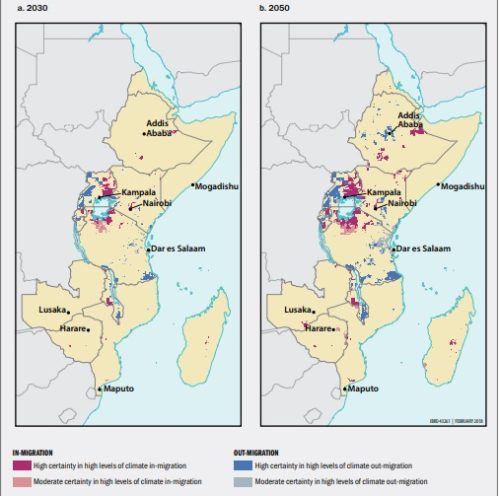
Projected climate in and out migration in East Africa to 2050
Climate migration to 2050
The scale of internal climate migration is projected to ramp up by 2050 and then accelerate unless concerted climate and development action is taken.
Climate variability, and particularly drought in dryland areas has been a common driver of migration in the region. In 2017, population of East Africa was 442 million. Under a number of forecast scenarios, the number of climate migrants is projected to increase from 1.9-2.7 million in 2020 to 6.9-10.1 million by the middle of the century. Countries can expect to see hotspots of climate induced in- and out-migration, as shown above.
Climate change impacts can act as inhibitors or drivers of cross-border movements e.g. excessive precipitation has increased international migration from Senegal, but heatwaves have decreased migration from Burkino Faso. Overall given projected increases in temperature in East Africa, even modest increases in rainfall are likely to be offset by increases in potential evapotranspiration, rendering much of the region hotter and drier. Dar es Salaam is expected to experience dampened population growth due to rising sea levels and storm surges.
Migration hotspots
Climate out-migration hotspots occur in areas of deteriorating water availability and crop productivity. Climate out-migration hotspots include northern parts of the Ethiopian highlands; parts of western Uganda, southern Rwanda, and southern Malawi; and coastal stretches of Kenya and Tanzania. In the coastal zone, declining land availability, reflecting sea level rise and storm surges, is also a factor. Climate in-migration hotspots focus on climate favourable highland areas including the southeastern highlands of Ethiopia, the Lake Victoria basin, and the region near Lilongwe, Malawi, as well as isolated pockets of other countries.
Action across three major areas can help to reduce these projected trends reducing the number of people being forced to move in distress:
- Cut greenhouse gases now – strong action is needed to meet the Paris Climate Agreement goal of limiting future temperature increase to less than 2 degrees by the end of the century
- Enable climate migration in development planning – international frameworks are required related to climate migration
- Invest now to improve understanding of internal climate migration
References
- World Bank 2018 Groundswell: Preparing for Internal Climate Migration
- World Bank 2018 Groundswell: Preparing for Internal Climate Migration: Policy Note 1
